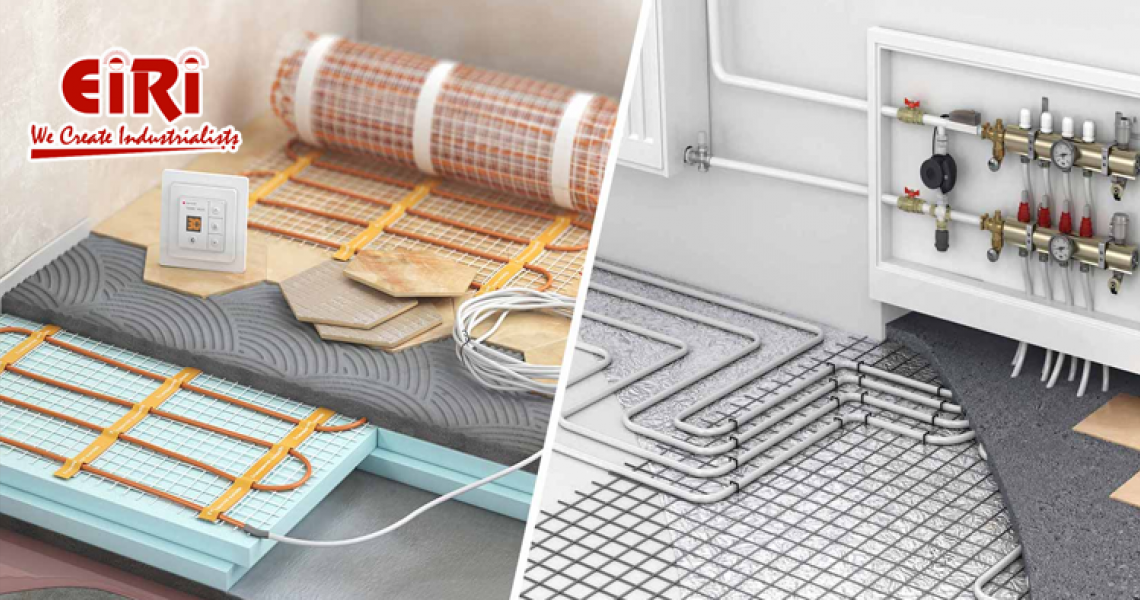The Electric Underfloor Heating Manufacturing Business : Complete Process and Know How

Underfloor heating, a cutting-edge solution for indoor climate control, involves the application of electrical or water systems beneath flooring to generate heat. Electric systems utilize cables to generate heat, ideal for smaller spaces like bathrooms, while water systems use pipes to circulate heated water, suitable for larger areas. This innovative heating method is essential for achieving optimal indoor comfort.
The Underfloor Heating Market, valued at USD 3.9 billion in 2022, is set for substantial growth, with projections reaching USD 6.53 billion by 2032, driven by a 5.90% CAGR.
The modes employed for underfloor heating include Conduction, Radiation, and Convection. Conduction, prevalent in solids and liquids, involves the transmission of heat energy through collisions between neighboring atoms or molecules. Convection, on the other hand, relies on the movement of fluids, such as liquids or gases, between areas of varying temperatures. This approach encompasses a crucial element – Radiant Heating, where energy transfers from the emitter to the observer. Underfloor heating not only ensures temperature control but also creates an environment less conducive to microbial growth, contributing to improved indoor air quality.
Electric Underfloor Heating Mats Market:
Within the expansive realm of heating solutions, the Electric Underfloor Heating Mats Market emerges as a specialized niche. This segment focuses on manufacturing and distributing electric heating mats designed for seamless installation beneath various flooring surfaces. These mats, intricately woven with a network of heating elements, offer an efficient and uniform distribution of warmth throughout rooms. Widely embraced in residential and commercial buildings, electric underfloor heating mats provide a discreet and energy-efficient alternative to conventional heating systems.
In 2022, the Underfloor Heating Market, valued at USD 3.9 billion, is poised for significant growth. Projections indicate a market surge from USD 4.1301 billion in 2023 to USD 6.53 billion by 2032, manifesting a robust compound annual growth rate (CAGR) of 5.90% during the forecast period (2023 - 2032). The market's enhanced value is attributed to the increased adoption of underfloor heating systems, serving as key drivers for market expansion.
The market's growth is fueled by the escalating demand for comfortable and controllable heating solutions. The unique advantages of space-saving installation and reduced energy consumption further propel its popularity. These mats exemplify a marriage of technology and comfort, reflecting a paradigm shift in the way we perceive and experience indoor heating.
Underfloor Heating System Types:
The Underfloor Heating market segmentation by system types encompasses Dry/Electric and Wet/Hydronic. The dominance of the wet/hydronic segment is notable, fueled by the energy efficiency and uniform heat distribution offered by hydronic systems. This aligns seamlessly with the escalating demand for sustainable and comfortable heating solutions, especially in regions with colder climates or stringent energy cost considerations.
Underfloor Heating Offerings:
Segmented by offerings, the market is categorized into hardware and services. The hardware segment takes precedence, playing a pivotal role in physically implementing underfloor heating systems. Customers prioritize reliable and high-quality components to ensure the effective operation of their heating systems. The availability and performance of hardware components significantly influence overall customer experience and satisfaction.
Underfloor Heating Installation Types:
The market segmentation based on installation types includes new and retrofit installations. The retrofit installations segment emerges as the frontrunner, offering a pragmatic avenue to upgrade existing buildings with underfloor heating systems without extensive construction or alterations. This makes it an appealing choice for homeowners and building owners seeking to enhance comfort levels and energy efficiency without undertaking significant renovations.
Regional Insights:
Geographically, the study delves into the Underfloor Heating Market across North America, Europe, Asia-Pacific, and the Rest of the World. The North American region is slated to dominate the market, driven by factors such as the introduction of energy efficiency standards, rising standards of living, and the demand for underfloor heating solutions to combat extreme climatic conditions.
As the Underfloor Heating Market undergoes substantial expansion, the interplay of technology, comfort, and sustainability takes center stage, shaping the future of indoor climate control.
Future of Residential Electric Underfloor Heating
The Residential Electric Underfloor Heating Market, valued at $2.76 billion in 2022, anticipates substantial growth, projecting a CAGR of 8.1% to reach $4.84 billion by 2029. This market surge is fueled by the increased adoption of underfloor heating systems, positioning them as vital drivers for market expansion.
Rising Demand: The market experiences heightened demand driven by factors like growing awareness, affordability, and efficiency. The preference for energy-efficient heating systems is escalating, with electric underfloor heating providing even heat distribution, surpassing traditional methods.
Technological Advancements: Innovations in technology facilitate the use and installation of electric underfloor heating equipment, expanding its application across various industries. The construction boom and infrastructural development in cold regions contribute to the market's global growth.
Impact of Constraints:
Installation Complexities: The initial high installation cost, energy consumption, and a shortage of skilled workers pose challenges. DIY attempts and retrofitting in smaller spaces add complexity, hindering the market's potential growth.
Market Opportunities:
Sustainable Development: The global demand rises with a focus on new energy-efficient and sustainable development, reducing reliance on non-renewable energy sources. Continuous innovation leads to eco-friendly designs, fostering awareness and encouraging efficient product installations.
Challenges Ahead:
Skilled Workforce: A scarcity of skilled workers hampers implementation, while environmental concerns regarding increased electricity usage impact market dynamics. Challenges in heating efficiency in colder regions and limited space for product utilization also pose hurdles.
The Residential Electric Underfloor Heating market embraces opportunities, addresses challenges, and evolves as a pivotal player in the quest for energy-efficient and comfortable heating solutions.










